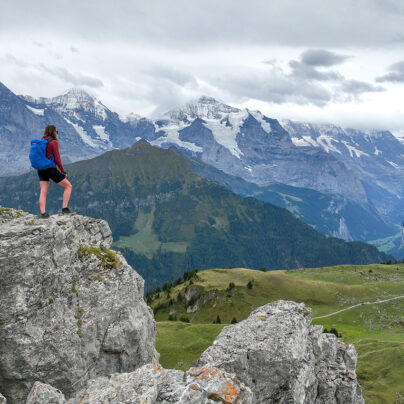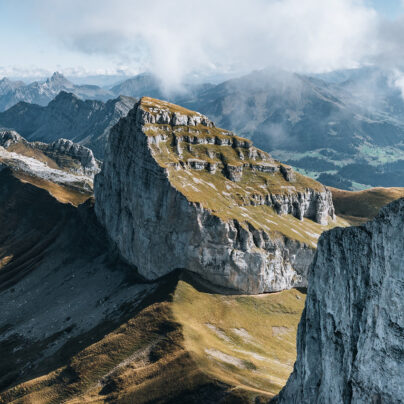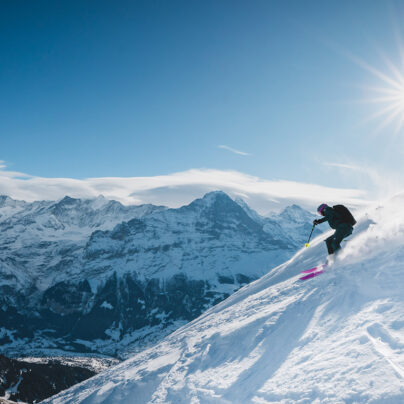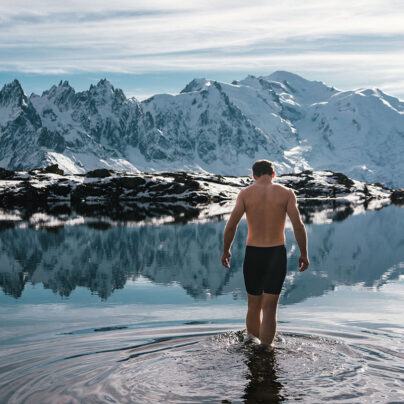Paddling the Dragon’s Breath
John Summerton
The sunrise hits the jagged peaks of the escarpment and illuminates it in golden light. Rolling morning mists can often be seen below, far off into the distance, and sometimes over the water. This is the Dragon’s Breath.
I wake up with my nose pressed against the side of our tent. The movement dislodges ice, which falls to the grass with a shiver; more ice slides down the fabric when I unzip the tent door, and I look out. The sun is shedding the first of its deep orange light across the tops of the Welsh mountains. The cloudless sky is changing from a sea-blue to Arctic blue, and our paddleboards are frosted like ice sculptures. That it is so cold shouldn’t be surprising – we are camped at almost 600m, just below the highest peak of the Black Mountain range in the Brecon Beacons, and it’s April – but what I didn’t expect was just how deep the cold would be. I click on the stove for coffee, and then I see it: the Dragon’s Breath, and it takes my own breath away.
***
Almost a year before to the day, I had been walking along the ridge of Fan Brycheiniog, the highest point of the Black Mountain range. Like much of the Brecon Beacons, it rises slowly from the south before crashing dramatically to the north and east. At the bottom of this geological tumble is Llyn y Fan Fawr, one of two major lakes in the Black Mountain range (not to be confused with the Black Mountains, confusingly).
It was foul weather when I was here last, driving wind and horizontal rain – barely any visibility. I could see about three steps in front of me on the narrow ridge path, but the ranger I’d spoken to beforehand had told me of this incredible lake 400m below. He told me how the sunrise hits the jagged peaks of the escarpment and illuminates it in golden light. He told me how rolling morning mists can often be seen below, far off into the distance, and sometimes over the water. He called the phenomenon the Dragon’s Breath. This I had to see.
And so a plan started to form over the last year: to bring a stand-up paddleboard up the mountain, to paddle the remote lake, and experience the daybreak spectacle. With a few casual WhatsApp messages to friends, a token glance at some old OS maps, and a serious sacrifice to the weather gods, I eventually found my way driving with a couple of compact SUP boards, minimal food and minimal camping equipment to the far end of the Brecon Beacons to meet up with a couple of willing participants. I had around 24 hours, and couldn’t think of a better way to spend it.


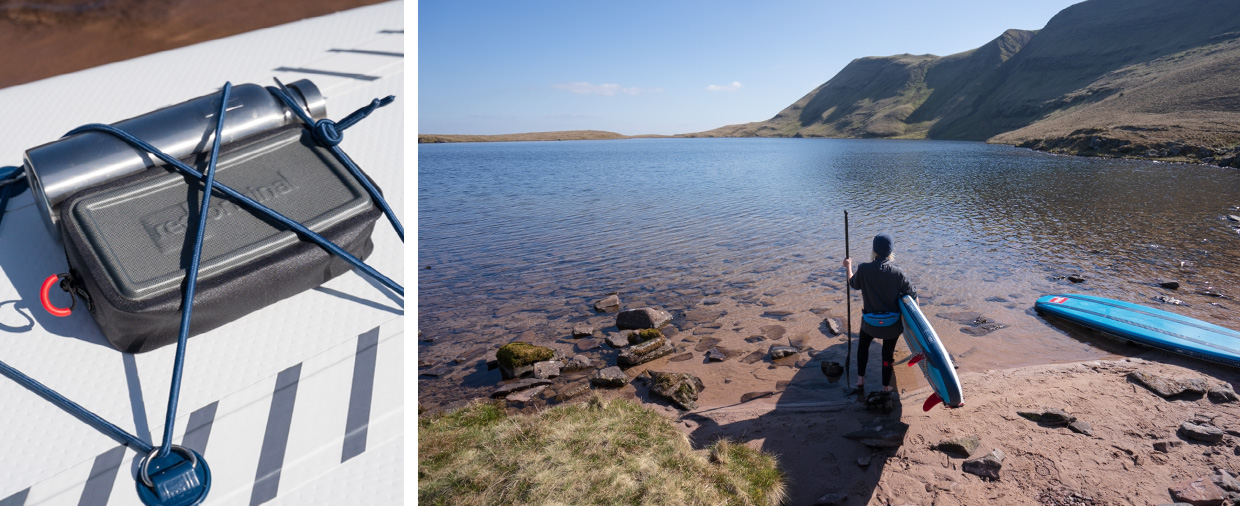

Laura and Barry beat me to the car park and were waiting impatiently as I pulled up. Conditions the day before had been much the same as on my last visit, but clearly the weather gods had heard my promise (not to drink beer for a week if they can make the sun shine, really) and, although soggy underfoot and with a sharp breeze, the sun was out. The forecast looked perfect for the following morning.
We loaded up. With a paddleboard on our backs, even these compact ones, this was never going to be fast and light. After loading up our boards and slinging packs on our front, we started the trudge up a rocky path away from the car park, stopping regularly to take in the views (and breathers). The plan was to walk up to Llyn y Fan Fawr, climb onto the ridge, and descend to our night’s camp spot – Llyn y Fan Fach, the smaller of the two brothers.
By lunchtime, we’d arrived at the first lake, Llyn y Fan Fach. Barry was keen to get the boards inflated and out onto the water, but the wind had some bite to it, and the whole lake lay in the shade. But we found the rumour about the spectacular waters that awaited us at the next lake too tempting. We pushed on.
The gradient steepened, layers came off, and I dripped with sweat. We’d only climbed 500m or so but because of the gear we were (unaccustomed to) carrying this was a slow trudge up a big mountain. Looking high up onto the ridgeline, more sensible people than us were skipping along merrily – relatively speaking. I started to regret the whole idea. As so often with planning these trips, I’d painted the perfect picture in my mind, but this was turning out to be very different. What if the view doesn’t live up to my expectations (and the promises I’d convinced my team with)? What if there’s no sunrise? What if this is going to be a drudge?
It’s easy to get into a negative headspace quickly. It happens on every trip; a friend calls it the ‘hate zone’, a fleeting moment in which you think that, no matter how stunning the scenery and how great the company, you’d much rather be elsewhere – but then, looking out for miles over the unpopulated moorland and the soaring ridge formed 60 million years ago, imagining the stone-age history of the mountain’s burial mounds and watching the red kites soaring above us, perspective returned. It wasn’t a bad day off work, after all. And what if dawn was as magical as promised? We pushed on.
Looking out for miles over the unpopulated moorland and the soaring ridge formed 60 million years ago, imagining the stone-age history of the mountain’s burial mounds and watching the red kites soaring above us, perspective returned.



The clear weather had revealed the renowned starry skies of the Brecon Beacons, some of the clearest in Europe and an International Dark Sky Reserve.
We wound our way up and around the heel of the mountain and, finally, a couple of kilometres below, we could see the lake. Our lake. Glaciation formed the lake around two million years ago, a baffling number. Buoyed by this discovery, we picked up the pace and pushed down the narrow track to arrive at an exquisite cove on the western shore.
Wasting no time, we unloaded and inflated our paddleboards, eager to get out on the water and get those aching muscles moving. Within a few minutes, Barry had pushed out into the clearest, freshest and calmest water I’d ever seen. Taking turns, we circumnavigated the lake, exploring every corner, relishing in the last warmth of the sun. But – earlier than hoped – we were in the shadow of the soaring ridge, the water turned black, the temperature dropped, and the lake took on a menacing aspect… so we ate.
We made camp, had a filling meal of chorizo, bean and rice paella-style, with a few warming sips of Legend – the local whisky from Penderyn distillery – and prepared for the morning, enjoying the rarity of almost total silence. I felt far, far away from anyone, from anything. As I was about to zip up the tent, I glanced out. ‘Get up, Barry; we’re going paddling’. The clear weather had revealed the renowned starry skies of the Brecon Beacons, some of the clearest in Europe and an International Dark Sky Reserve. To paddle out here, on flat inky water, under this luminescent starscape, was a rare treat.
The boards were icing over by this time, thick frost already hanging in the air ready to coat everything. But we pushed out once more into the water, to stand, floating in the silence and absorb this scene. Finally, grinning from an experience that few have ever had, we clinked on another dram and tried to sleep.



And so, as the alarm wakes me at 5.40am, 30 minutes before sunrise, I groggily and grumpily extract myself from my warm cocoon. Thick frost falls from the door directly into my shoe, and my laces are frozen solid. ‘Gonna be a chilly one.’ Barry and I get out to sort the gear, leaving Laura to hit the snooze button without her smelly, shuffling bunkmates.
We can see the sky lit up over Pen y Fan – Fan Brycheiniog’s more famous neighbour to the east – and the sun sitting about 20 minutes below our horizon. And then, down in the valley, the Dragon’s Breath rolls in, creeping eerily over the ground towards us. The Dragon is waking.
The lake is mirror-like, calm, and waiting for us. Soon, with the sun glinting on the horizon, the ridge above the lake starts turning from its grey-green hue to a polished gold colour, like a church sceptre.
Barry paddles straight out into the water. I am mesmerised: by the colours, by the location, by the experience. The faintest whiffs of Dragon’s Breath skim across the lake, but the sunshine quickly extinguishes them.
For an hour we wonder at the scene, paddle the lake, break fresh, flat water and wonder some more. And then, with numb hands and toes and grins frozen to our faces, we pull back to shore. We’d taken time off, driven for miles into the wilderness of Wales, slogged for hours up the mountain (and now face a painfully cold pack down and hike back to the car) all for an hour’s paddle. We never once questioned if it was worth it.
For more information on the 9’6” Compact Paddle Board from Red Paddle Co visit redpaddleco.com.
Words and photography: John Summerton
With Barry Wallace & Laura Dennis
Produced in partnership with Red Paddle Co and Red Original




